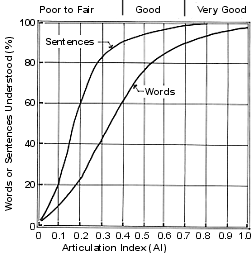

Background noise is a significant contributing factor to poor intelligibility in classrooms. This may be background noise created by HVAC systems, fluorescent lighting ballasts, classroom activities, or exterior noise like traffic on nearby roadways and aircraft flyovers. To show how significant the effects are of noise, we have taken our well-behaved classroom with the 0.6 second reverberation time and plotted Articulation Index for several background noise levels. We plotted the AI for five noise levels that have been commonly measured in classrooms, NC-50, NC-45, NC-40 and NC-35 and NC-25. It should be noted that the prefered criteria for hearing impaired accessible classrooms is a much more stringent NC-25, and you can easily see the significance of reducing the background noise level that additional 10dB.
Articulation Index is a subjective measure of speech intelligibility that describes the percentage of words that a listener hears correctly. This is extrapolated in these computer generated model plots from the reverberation time and background noise levels for an unaided voice in our classroom. In this particular case we have a short reverberation time. As the reverberation time increases, it adds to the background noise level caused by various noise sources in the room, as well as adding "noise" related to the speech communication itself. In the end it all becomes more noise that the brain has to process to hear the words clearly.

See the chart above to see how the percentage of words understood relates to the AI value, and also to the percentage of sentences understood. No surprise here, when words are in the context of a sentence we have a better chance of understanding the word. Take for example an AI rating of 0.7: for single words the score is at about 90% understanding; and for words in a sentence, we're up at something close to 98% understanding.
This is not a linear relationship, this is a hysterisis curve, to achieve high AI values it is necessary to have a very high percentage of words understood. Think of a simple sentence like: "the quick brown fox jumps over the lazy dog." If you only understood 80% of the words (an AI of .28 for a sentence), that might sound like; "The quick brown &3@ jumps over the lazy d%2."
Scale that up to a sentence like: "This means that as the delta-x gets very small, the difference between the value of the function at x and the value of the function at x + delta-x divided by delta-x is the derivative." If a student only understood 80% of the words in that sentence it might sound like: "This means that as the dteiw-x gets very small, the sfetlstrqi between the value of the kgfyrlsyrfu at x and the value of the function at x + delta-x cxdstey by dazdayh-x is the dkltrisreje." No wonder calculus gives so many students trouble.
An AI of 0.7 or better is considered very good for communication, an AI of 0.4 to 0.7 is considered good, and an AI of 0.1 to 0.4 is considered poor to fair. Obviously in a classroom a higher value is better, and if students comprehend better than 90% of the words they hear, they are more likely to understand the information they are being taught. The following plots show the percentage of words that would be understood in this room. In the simplest terms, the greater the area of red coverage in the following plots, the better the inteligibility is in the room.
This would be considered a very noisy room, but not atypical of classrooms that one does find in the real world. Note that the entire display range runs from a high of 93% down to a very low 18%, covering a range of Very Good to Poor. That means that this room has some serious intelligibility problems anywhere beyond the small yellow area, which is about 70%. That is barely beyond arm's length.
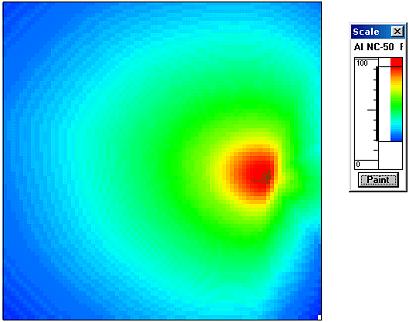
This room is a bit quieter, but the entire display range is still quite wide, 93% down to a low of 35%, which still covers the range from Very Good to Fair. The 70% distance is still only about 10feet or 3m from the talker.
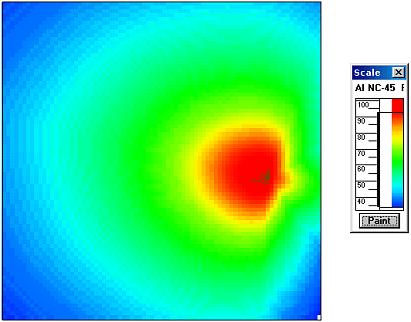
This room is quieter yet, the entire display range runs from 93% down to about 47%, just barely into the Good range on the low end. There is a large percentage of the room that is better than 70%, but you wouldn't want your kids sitting in the back of the room.
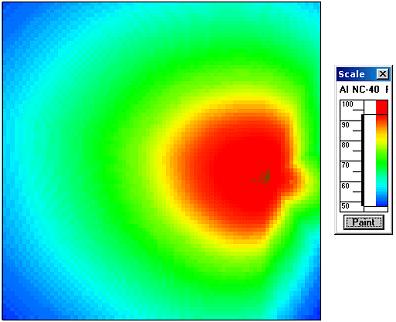
This room is getting into the range of an affordable well-behaved classroom. Almost all of the classroom has an AI greater than 70%, and the total range is 93% down to a low of 62%. The entire room is Good to Very Good (but is it good enough?).
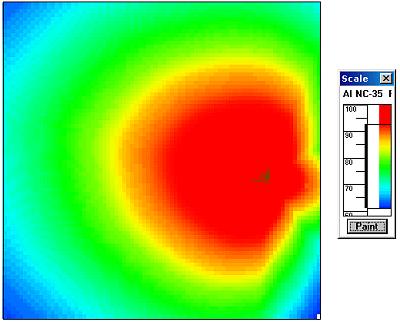
This room has absolutely stellar AI performance. That last 10dB nets some serious improvements in Articulation Index. The entire display range is from 92.7% down to a low of 90.8%. This entire classroom has Very Good speech intelligibility. Anyplace in the classroom will have good intelligibility.
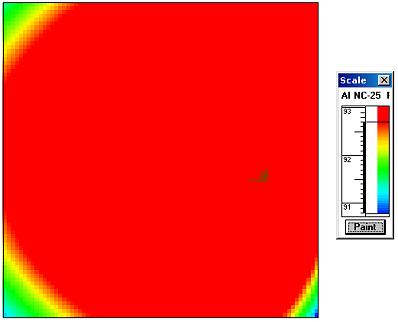
Keep in mind that just because the empty room may have a low background noise level of NC-35, it doesn't mean that the noise level might not increase temporarily. If the noise level jumps to NC-50 during aircraft flyovers, or having a boom car in the parking lot nearby, or when the HVAC kicks on at high velocity, or the class gets noisy (laughter, coughing, chatter etc.), the intelligibility will drop for the duration of the elevated noise levels. The control of reverberation time in the classroom will at least minimize the overall noise level changes that are created by short duration local noise sources (coughing children, dropped books etc.).
![]() Control the noise levels, control the reverberation time and deliver good direct sound levels to the class, and you will improve the intelligibility in the classroom.
Control the noise levels, control the reverberation time and deliver good direct sound levels to the class, and you will improve the intelligibility in the classroom.
Main Page > Design Services > Schools > Back to Classroom Background Noise Page